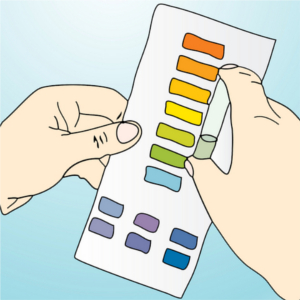

A Keeping your fish healthy requires careful maintenance of the aquarium. The best way to ensure water quality is to test the freshwater aquarium on a regular basis. There are several tests to use:
Ammonia
Testing the ammonia levels in the aquarium is necessary to see if your biological filter is working. Most tests simply use a strip that is dipped in the water and the color compared to a chart. If the test detects ammonia, your biological filter needs replacing. Lower the levels by replacing the water, reducing the number of fish and avoiding overfeeding.
pH Levels
Another strip test that checks the acidity of the water. If the water is too acidic or too basic, your fish will sicken and die. Dip the strip into the water and check the color against the provided chart to determine acidity. Remember, 7.0 is neutral, anything higher is alkaline and lower is acidic. Fish usually thrive between 6-8 on the scale. If needed, pH levels can be corrected by adding corrective drops that may come in the testing kit. Crushed coral can also help raise pH if it is too high and peat will lower it.
Nitrate
Nitrate tests essentially measure nitrate and nitrite, both forms of nitrogen. Too much nitrate (over 50 ppm) is toxic to your fish. It builds up gradually and can be removed with regular water changes. The test involves adding two solutions to the test sample and checking the color against a chart.
Nitrite
Nitrogen in high levels is toxic to fish. This test requires adding sulpheric acid and iron sulphate to a sample of aquarium water. A brown color resulting from the mixture indicates the presence of nitrogen. The biological filter should be replaced and fresh water cycled into the tank.
It's important to the health of your fish to test regularly and to keep the aquarium water at the right levels.
Saltwater aquariums are considerably more difficult to maintain than freshwater and require diligence in the area of water testing. You need to stay on top of the various levels in the water. To help, there are many tests you can use; here are the most important ones.
Ammonia
Ammonia levels rise with the number of fish and waste products. It can be deadly if allowed to build up. You can test for ammonia with strips of prepared paper dipped into the water and then checked against a color chart. Any ammonia at all should be treated by changing the water and replacing or cleaning the biological filter.
pH Levels
This test check for acid or alkaline water. If pH levels are too far in either direction and fish will die. Saltwater fish tend to prefer alkaline water, with a range of 7-10 on the pH scale. To test, dip the test strip in a water sample and match the color to the chart provided. You can use corrective liquids to correct the pH if necessary, though crushed coral is better for reducing acidity.
Nitrite
The test for nitrogen involves adding two testing substances, sulpheric acid and iron sulphate, to the test sample. A brown result indicates nitrates are present, meaning the bio filter needs to be changed. This is, however, normal during cycling. Changing the water will resolve the issue.
Salinity
For saltwater aquariums, a hydrometer will give you an accurate reading on how much salt is in the water. This is important since too much or too little salt will cause fish to become ill or die. Adding more fresh water or increasing the amount of salt mixture will create the perfect environment.
Saltwater aquariums require frequent testing since they are more delicate than other aquariums. Staying on top of water conditions means you will have healthier fish.